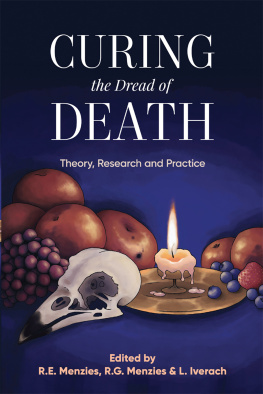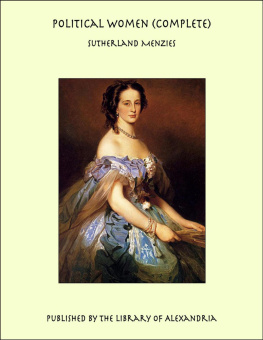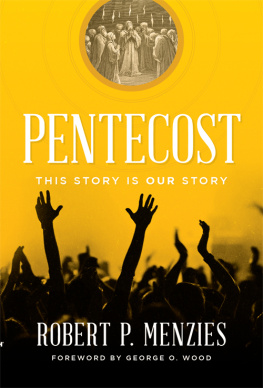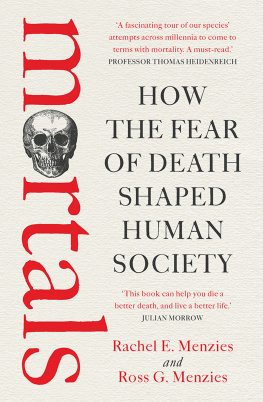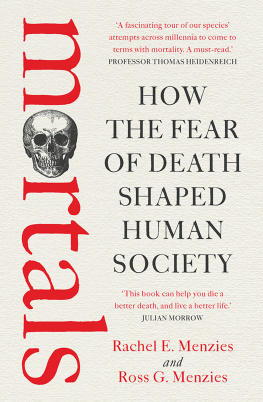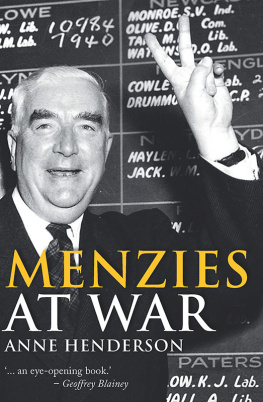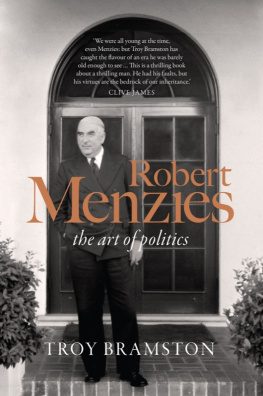Menzies R. E. - Curing the Dread of Death
Here you can read online Menzies R. E. - Curing the Dread of Death full text of the book (entire story) in english for free. Download pdf and epub, get meaning, cover and reviews about this ebook. year: 2020, publisher: Australian Academic Press, genre: Religion. Description of the work, (preface) as well as reviews are available. Best literature library LitArk.com created for fans of good reading and offers a wide selection of genres:
Romance novel
Science fiction
Adventure
Detective
Science
History
Home and family
Prose
Art
Politics
Computer
Non-fiction
Religion
Business
Children
Humor
Choose a favorite category and find really read worthwhile books. Enjoy immersion in the world of imagination, feel the emotions of the characters or learn something new for yourself, make an fascinating discovery.
- Book:Curing the Dread of Death
- Author:
- Publisher:Australian Academic Press
- Genre:
- Year:2020
- Rating:3 / 5
- Favourites:Add to favourites
- Your mark:
- 60
- 1
- 2
- 3
- 4
- 5
Curing the Dread of Death: summary, description and annotation
We offer to read an annotation, description, summary or preface (depends on what the author of the book "Curing the Dread of Death" wrote himself). If you haven't found the necessary information about the book — write in the comments, we will try to find it.
Curing the Dread of Death — read online for free the complete book (whole text) full work
Below is the text of the book, divided by pages. System saving the place of the last page read, allows you to conveniently read the book "Curing the Dread of Death" online for free, without having to search again every time where you left off. Put a bookmark, and you can go to the page where you finished reading at any time.
Font size:
Interval:
Bookmark:

Contents

First published 2018 by:
Australian Academic Press Group Pty. Ltd.
18 Victor Russell Drive
Samford Valley QLD 4520, Australia
www.australianacademicpress.com.au
Copyright 2018 rests with the identifies authors for all contributions to this book.
Copying for educational purposes
The Australian Copyright Act 1968 (Cwlth) allows a maximum of one chapter or 10% of this book, whichever is the greater, to be reproduced and/or communicated by any educational institution for its educational purposes provided that the educational institution (or the body that administers it) has given a remuneration notice to Copyright Agency Limited (CAL) under the Act.
For details of the CAL licence for educational institutions contact:
Copyright Agency Limited, 19/157 Liverpool Street, Sydney, NSW 2000.
Production and communication for other purposes
Except as permitted under the Act, for example a fair dealing for the purposes of study, research, criticism or review, no part of this book may be reproduced, stored in a retrieval system, or transmitted in any form or by any means electronic, mechanical, photocopying, recording or otherwise without prior written permission of the copyright holder.
Curing the Dread of Death: Theory, Research and Practice.
ISBN | 9781925644111 (paperback) |
ISBN | 9781925644128 (ebook) |
Disclaimer
Every effort has been made in preparing this work to provide information based on accepted standards and practice at the time of publication. The publisher and authors, however, makes no warranties of any kind of psychological outcome relating to use of this work and disclaim all responsibility or liability for direct or consequential damages resulting from any use of the material contained in this work.
Publisher: Stephen May
Copy Editor: Rhonda McPherson
Original cover art: Morgan Lawrence
Cover design: Luke Harris, Working Type Studio
Typesetting: Australian Academic Press
Printing: Lightning Source
Dedication
For Mum, Dad and Lachlan. Thank you for your
endless love and support REM.
For James William (Jim) Ovens, who showed me the
art of dying RGM.
For John and David, who have taught me
to embrace the complexities of life with strength
and tenderness LI.
The opening chapter reviews the way in which various cultures have dealt with death from ancient times until the present. The role of death anxiety in myth and ritual, religion, art and literature are explored. It will be argued that communities across history have developed a range of ways to deny and conquer death.
This chapter traces the natural history of death anxiety across the lifespan. The developmental literature will be reviewed to explore childrens growing understanding of the construct of death across the first decade of life. The moderating factors of gender, age, religiosity, and health status are reviewed, as is the intriguing observation that death fears typically diminish in the last decades of life.
Kuperus overviews the common threads in the philosophic positions of Sartre, Nietzsche, Camus, and related European philosophers of the late 19th century and early 20th century. The central existential concepts of absurdism, angst and responsibility will be introduced. It will be shown that existentialism emphasises the significance of living this life well, rather than fearing death.
Mikulincer applies attachment theory to explain the ways people experience and cope with the existential concerns of mortality and meaninglessness. The chapter reviews evidence that a sense of attachment security a sense that the world is generally safe, other people are generally helpful, and Im valuable and lovable provides a psychological foundation for easing existential anxieties and constructing an authentic sense of continuity, coherence, meaning, connectedness, and autonomy.
It is a broadly held view that Sigmund Freud dismissed death as being of little significance to our psychic struggles. While superficially true, this bland claim is an oversimplification of his theoretical position. Menzies and Menzies explore the contradictory nature of Freuds theorising on the death instinct and death anxiety, before examining modern psychoanalytic conceptions of our dynamic struggle with death.
In this chapter, an intelligent design theory of the origins and functions of religion is developed by integrating useful ideas from both evolutionary and existential perspectives. Pyszczynski and Thompson argue that integrating evolved cognitive proclivities emphasised by evolutionary theories with the emphasis on the motivational and emotional forces that bias these processes provides a more complete understanding of the origins and function of religion.
Lisa Iverach examines the evidence suggesting that death anxiety is a transdiagnostic construct that underpins the anxiety disorders, obsessive-compulsive disorder (OCD), panic and somatoform disorders, mood disorders and even eating disorders. It is argued that death anxiety must be tackled directly to improve long-term outcomes in mental health.
This chapter explores possible misinterpretations of the existential philosophers that have been made by the public, various writers, and even some developers of existential therapeutic schools. Reductionist and nonreductionist existential therapies are described in detail. Finally, an integrative existential-psychotherapeutic perspective on death will be suggested, with an overview of specific competencies and a review of empirical evidence.
This chapter provides a review of the central cognitive and behavioural procedures that have been trialled in the treatment of death anxiety in clinical and non-clinical populations.
No group more directly face death and impermanence than the terminally ill. Accordingly, end-of-life care may inform the treatment of death anxiety. The range of psychological approaches used in end-of-life care will be described and reviewed.
Detachment from loved ones who have died is often considered to be a healthy grief response in western societies. However, in more collectivist cultures it is argued that continuing ties to loved ones who have died is an important part of grieving. This chapter will explore the application of continuing bonds as part of grief therapy.
Terror management theory proposes that high self-esteem buffers against death fears and existential dread. Individuals with low self-esteem have been shown to be particularly vulnerable to mortality priming in the laboratory. Accordingly, this chapter reviews the literature on various cognitive behavioural approaches to low self-esteem. Emphasis is placed on incorporating terror management theory (TMT) into cognitive behaviour therapy (CBT), acceptance and commitment therapy (ACT) and dialectical behaviour therapy (DBT) when dealing with self-esteem.
Drawing on material presented in earlier chapters, and European existential thinking, this chapter provides an overview of therapeutic interventions for dealing with and confronting the fear of death. Starting from a case example, the authors explore religious and philosophical approaches as well as ways of including therapeutic tools such as literature and music in the therapeutic context.
Font size:
Interval:
Bookmark:
Similar books «Curing the Dread of Death»
Look at similar books to Curing the Dread of Death. We have selected literature similar in name and meaning in the hope of providing readers with more options to find new, interesting, not yet read works.
Discussion, reviews of the book Curing the Dread of Death and just readers' own opinions. Leave your comments, write what you think about the work, its meaning or the main characters. Specify what exactly you liked and what you didn't like, and why you think so.

